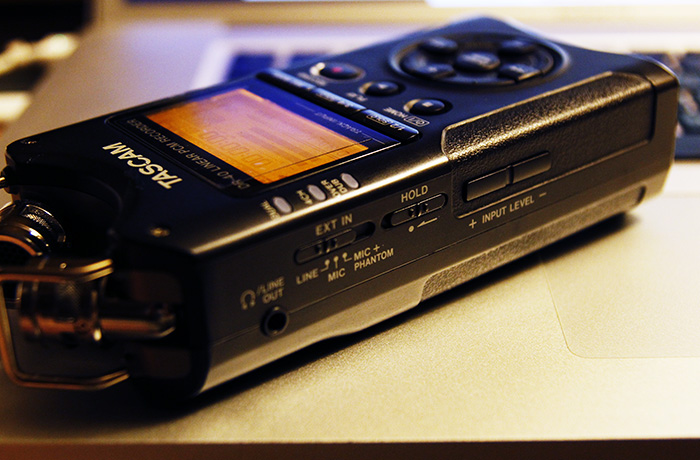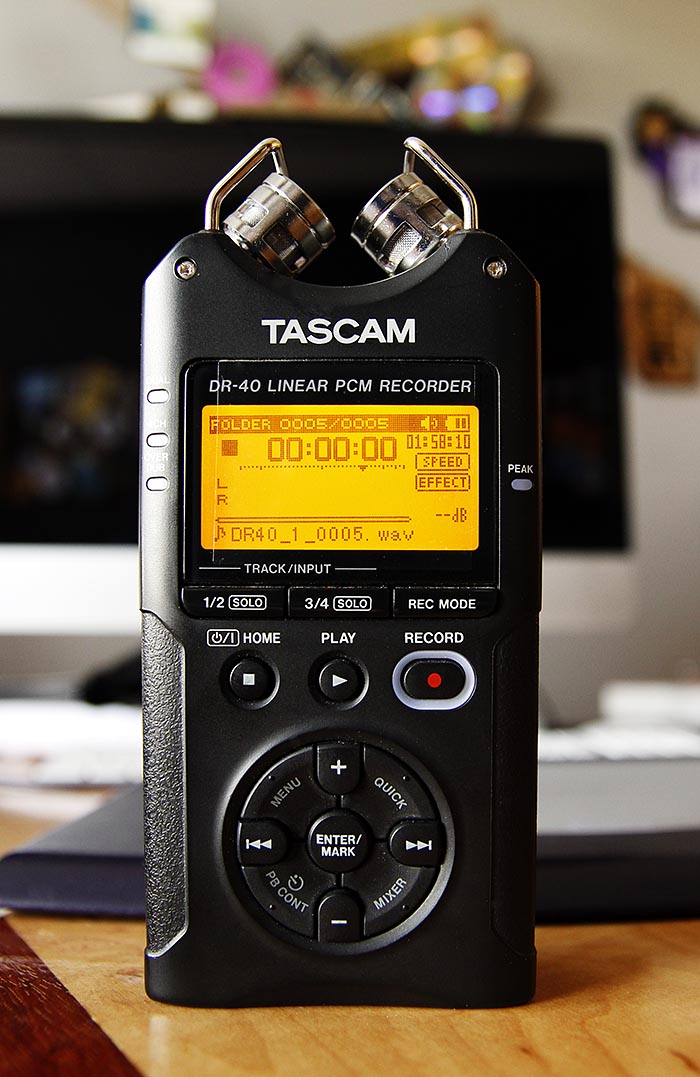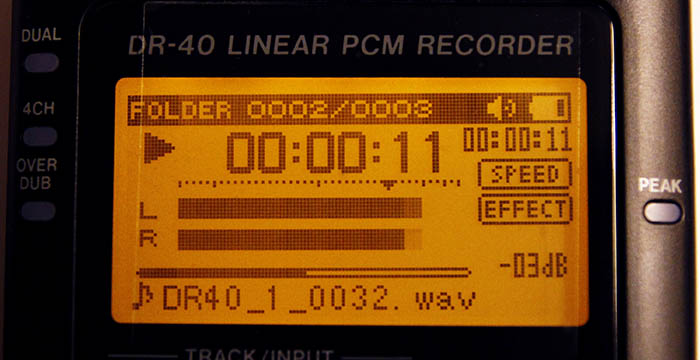Tascam DR-40 Recorder Review
The Tascam DR-40 is another entry into the basic audio recorder category. It can record up to 4 tracks at once – the two internal mics and / or the two external outputs. While you can record 96khz 24bit thats probably a bit of a waste and 48K 24bit is all you’ll really need. My main interest in this unit was to add it to my sound bag when working with my mixer to add on board recording. While I do have a DR-680 that I really like, its big in comparison and I was looking for a small light solution. I normally either have the mixer or DR-680 in the bag at any given time, not both.
The DR-40 is compact enough for the job running on 3 internal AA batteries for hours. It uses standard SD cards for recording that easily go in and out of the side of the unit. It comes in fact with batteries and a 2gb card to get you recording as soon as you open the box. While 2gb is ok, I had a 8gb card I used instead. I formatted the card in the recorder before using it for the first time as the DR-40 does want to have its own folder. It records standard WAV, BWAV and MP3 files. The DR-40 will function as a USB SD card reader so you can directly access the SD card and dump the sound files onto your mac or pc.
Out of the box you’ll note the 2 built-in mics have wire metal bumper guards. With the mics facing in they will do the job as I carried this unit around for a couple of days in my pocket and all was well.
There are several side switches and buttons on the front. If you have worked with other Tascam products the menus will be familiar. They are simple and easy to figure out without reading the manual for the most part. Even just playing around with the unit for a few minutes I ran thru all the options and pretty much figured out what I needed to get the unit setup the way I wanted. The actual LCD display itself is reasonably contrasty and has a backlight with programable stay on time. Also of note is that the REC button has a nice plastic ring around it lit by a LED that makes it easy to see you are ready to record or all ready rolling. Getting into record is basically instant and there is a pre-record feature if you need or want it.
The manual is available here http://tascam.com/content/downloads/products/706/e_dr-40_om_va.pdf and I’d suggest taking a few minutes to go through it.
Phantom Power : Yes this unit has phantom power which is selectable for either 48V or 24V. When you turn phantom power on via the side switch the unit will prompt you on the front display to enable it. This is both a safety precaution and to prevent higher power consumption on the unit by accident. Running phantom power tends to use up a lot of battery power. This is true on ANY device that must convert 4-12V up to 48V, not just the Tascam.
The HOLD Switch : Located on the side of the unit is a hold switch. Its a good idea when you are in record, moving around and want to be sure you stay in record. The problem is if you move the switch, by accident of course, into the hold position with the power off. The unit will not come on if the hold switch is on. It will act like its dead or your batteries are. It took me several minutes to catch this one and get the DR-40 to turn on after changing the batteries twice. I suppose one might be able to argue this feature could save an accidental power on and your batteries.
Sound Quality
I put a Schoeps CMC-64 into the inputs direct using 48V phantom power. It worked, it sounded pretty good. You could record dialog and be happy for a lot of work. I’d best describe it as having more bottom end and less high end. Less detail in comparison to feeding it with my mixer.
The preamps have a very low noise floor and the mic itself is pretty quite. So if your main criteria is noise levels, these preamps pass with flying colors.
So note this : I screwed up these tests a bit. I recorded low levels because the meters in the unit ( see below ) are really kind of deceptive. Literally 80% of the meters are dedicated to what looks like the area below -18db. The last 20% is the range you really care about, the range of -18db to 0db. What looked like good healthy levels was in fact recorded by me low. Live and burn sometimes, that’s why you do tests ! That said, my error wasn’t the worst. In fact I’d say in all fairness it represents the sort of error I think a lot of people could of made using the unit for the first time. Know your gear, right ?
Putting my mess up aside, boosting the low recording levels with 18-24db of gain was still very clean compared to some other recorders I’ve used. If I had to test how quiet the preamps really are, this was a great test… I just hadn’t intended to do . Please keep this in mind when listening to the recording samples.
Schoeps CMC 64 direct feed into DR-40 MP3 [ original files no longer available ]
In comparison, using my FP33 to feed line level into the DR-40 had a more accurate sound. It had more detail in the upper end. I’m pretty sure I had the low cuts on the mixer turned on so I probably biased the recording samples a bit in them having less bottom end.
FP33 Line level feed into Tascam DR-40 Sample [ original files no longer available ]
Line level sounded cleaner which is almost to be expected. My mixer has transformer isolated inputs and outputs along with a lot of head room if properly powered. So using this unit with an external mixer or pre map and feeding it line level is probably the best thing to do for best sound quality. If you are using this for recoding podcasts or news a mic on the direct input will be fine. I”m being critically picky here and in reality most folks will probably be happy with the built in pre maps for everyday recording.
The built in mics are also ok. They seem to have a lot of gain which makes them seem more sensitive than I think they really are. The built in mics sound decent. They are good enough for quick ambient recording or typical news gathering, especially if kept close enough. Of course keeping a mic close enough is important no matter what mic you have. Good mic placement is 50% of the game at least !
Built In Mic Recording Sample of the Tascam DR-40 [ original files no longer available }
There are furry wind covers you get get if you want to use the DR-40 outside. Tascam does not provide any basic foam windscreen though I’m sure some foam is inside the head of each mic. If wind rumble is a problem you can engage the low cut filter with 3 different cut in points as a starting point.
With the 2 built in mics you can record with them facing each other at 90 degs or flip them to face out. The unit will detect this and ask you to change from XY to AB recording modes. The DR-40 also supports MS recording and playback. I could easily picture facing them outwards for hand held interview recording.
The one down side is that the built in mics will pick up handing noise. So if you hand hold the unit don’t be rubbing your fingers on it or otherwise messing with it. Perhaps a pair of thin gloves might help if you really have to. I did use the unit a couple of times to get some ambient material with out a problem.
Recording modes
The DR-40 can record in a variety of modes including : X/Y or A/B stereo, MS stereo, Ch3/4 dual (linked), CH3/4 separate, any combination of 1/2 internal mics and or 3/4 external inputs, and can even record in a basic overdub mode playing 2 channels while recording. You can record 44.1, 48 and 96khz in 16 or 24 bits to various file formats.
The DR-40 also has a built in safety recording feature. You can record from any input pair and then record 2 more channels from the same source with some level of input reduction. This is the sort of split level records I’ll manually do sometimes when things are very unpredictable and you expect you may have hot levels you aren’t ready for. Safety is good !
Another very cool feature is the ability to add delay in ms to the external inputs. This is to compensate for delay when using external mics ( or board feed ) far away in comparison the internal mics so sound is in sync.
Here is a sample of the MP3 192kbits recording from the unit. I’m not thrilled with compression quality at all. Also consider I did boost the levels up which is aggravating, but if you did this on your job – MP3 recording format and levels a bit low you may not be happy with this.
MP3 sound sample from DR-40 [ original files no longer available ]
Input Processing
There several compression / limiting modes on the inputs. The manual is really a bit fuzzy on these, but they sound like none, hard peak limiting, auto levels and “limiting” thats more like soft compression. I didn’t have a lot of time to mess with these so you’ll want to try them on your own. I went with the hard peak limiting as I was usually using a mixer in front of the DR-40 and letting its limiters do the real work when needed.
There is a peak LED indicator on the front of the unit which is a nice help. As long as you don’t see it more than flash once in a while you should be good.
Input Levels
Every recorder seems to be a bit different. When working with my FP33 I set tone to +4db analog and then set the DR-40 to what I thought was -18db. This gives me about 14db of headroom before the FP33 limiters kick in and a couple more db before hitting digital 0. This seems to get reasonably good levels for me. The DR-40 seems to have a bit more gain on the inputs at line level as I set its internal input levels all the way down. Perhaps its set up for -20db consumer line level, or the Tascam engineers found that people tend to record levels that are a bit too low ( like I did the first time around ) and always want more gain. I didn’t have that problem with my mixer feeding the unit line level. Given how clean the preamps are this is a reasonable plan to give the user more gain when they could use it.
The meters on the DR-40 seemed pretty responsive and well tuned. Interesting side note : buried in a menu there is a tuner function in the DR-40 !
What was strange though was that the actual recording levels of the 48K 16bit wav files seem to be a lot lower than what the meters where telling me. This was true in both direct feed and mixer feed. I found myself applying 18-24db of gain in premiere pro to the clips to get them into the -18db to -12db range for normal dialog and what I thought I had been recording.
As I noted, this was my mistake by misreading the meters. Dear Tascam, please change the meter markings. Make the left 30% -128db to about -24db and use the rest of the meter space for -24db to 0. That would be a lot more useful !
When I did bring the levels up they where clean thanks in part to Premiere Pro’s high quality audio handling. Usable for most work but I should of gotten better levels in the files. Next time !
Output
The DR-40 pretty much does everything you’d want – playback 2 or 4 mix down channels with mix level and pan, M/S decode, delay effects and even variable speed playback. The only down side ? the only output is the 3.5mm headphone jack. There is a small speaker on the back of the unit for quick checks though.
Power
The unit runs for several hours on 3 internal AA batteries. I never managed to drain my rechargeables during testing of several hours on and off. I did watch the battery meter and it seemed accurate so I changed out on one bar rather than taking it all the way down. Tascam sells an external battery pack if you need extended recording time.
As for external power connector, there is none. OK, not the usual coaxial power connector just about everything has including other small Tascam recorders. Instead the choice was to use the USB port. I think this is a poor choice on every level. While you can power it from your laptop, or use a 12V->5V USB power adapter or wall power to USB adapter its far from being the ideal power connector. I’d tried it and it does work, but it won’t charge the internal batteries if you are using recharables and you should be. I’d recommend finding a right angle mini USB cable if you are regularly going to power this unit externally.
Sync
If you shoot dslr’s that’s about a 12 minute take per roll. Sync in my tests at 70deg F was 3500 samples or so off. At 24 fps its 2000 samples per frame or 2002.02 samples @ 23.976 but I like easy math. My measured distance was 3571 samples or nearly 2 frames difference at 12 minutes. Bummer because thats a noticeable sync difference. On the other hand, what do you expect for $150 or so? My DR-680 which costs 5X more does hold sync out to 12 minutes with a drift of about a 1/2 frame. What can I say, you get what you pay for ! Just be glad you’re not schlepping a Nagra around with its 10 D cells. So the bottom line is this recorder won’t hold usable sync for more than about 6 minutes at 24fps. At 30fps this would be 20% shorter before hitting 1 frames.
You could use this for sync sound, but you would be cutting your clip every 5 to 6 minus to slip it forwards a frame and then patch the gap. While this is possible to deal with it would not be my personal choice. Its also possible Plural Eyes can deal with the sync slippage too but I’m not sure this. If it can, or FCP X can the DR-40 may be very workable and affordable for you.
Conclusion
Its a great little recorder thats very affordable. Its perfect for simple recording work like taking a board feed of your band or news gathering. Its small size lets it fit in your pocket. Where the unit falls down is for sync sound over a few minutes. Its possible that with some variance in manufacturing you might get a unit that holds sync tighter or not. I don’t know. Either way the Tascam DR-40 should meet a lot of people’s needs for a small high quality inexpensive audio recorder.


